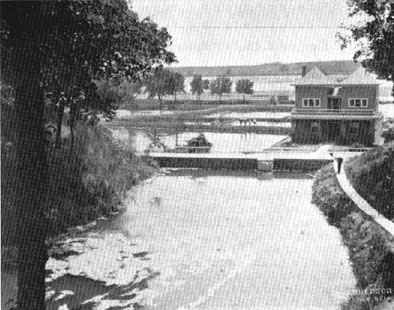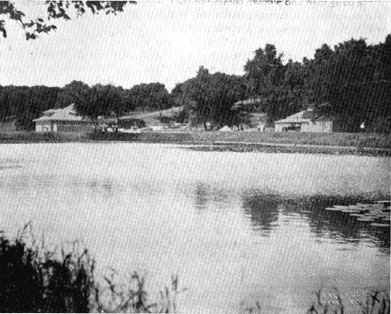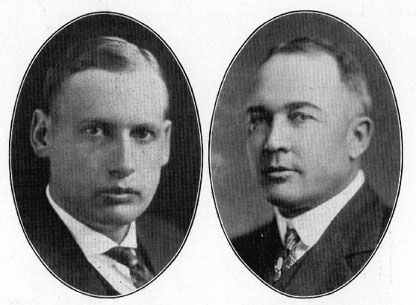![]()
Young men and women coming to the College and the School of Agriculture receive splendid technical instruction, enabling them to return to their farms and help to develop the agriculture and the social life of the communities from which they came. The College courses in Agriculture and in Home Economics are four years in length and lead to a degree of Bachelor of Science in Agriculture or in Home Economics. Many of the students graduating from these courses go back to the farms, but, as there is a great demand for technically trained men and women along these lines, a portion of them are employed as teachers and as investigators of agricultural problems, while some of them enter the service of the Government in the United States Department of Agriculture. The secondary School of Agriculture also offers a four year course leading to a certificate of graduation. Men taking this course go back to farms while young women who graduate may teach for a time in rural or town schools. 
State Fish Hatchery at South Bend |
![]()

Bass Pond, State Fish Hatchery at South Bend farm. New crops are investigated, new methods are tried, and varieties best suited to different areas are studied. Plant and animal diseases and insect pests are investigated and suppressed. During the last twenty years, the Experiment Station has assisted in working out such problems as the control of cholera in hogs and of blackleg in cattle, the development of rations most suitable for meat and milk production, the development and distribution of new varieties of grains and forage crops, the management of land, of orchards, and of special industries, and many other problems which relate to profitable production. |
![]()
At Mitchell, Nebr., a branch experiment station is conducted in cooperation with the United States Department of Agriculture, where problems in irrigation farming are studied under the conditions obtaining in the North Platte valley. |
![]()
such cases an effort is made to list all men who wish to purchase a particular class of commodities and men who have such commodities for sale. These lists are then exchanged, giving the purchaser an opportunity to communicate direct with the seller and thereby eliminate unnecessary handling and expense. Wool and mutton growing has never been developed in Nebraska as it should have been, nor as it is capable of being developed. Sheep feeding, however, has been successfully practiced for many years, the sheep being brought in from the ranges and fattened for market. For a number of years Buffalo county has been the foremost in the sheep feeding line, Shelton being one of the largest sheep shipping stations in the middle west. The late T. B. Hoard was one of the largest feeders of sheep in the west. There is no doubt that Nebraska is peculiarly well adapted to the production of mutton and wool. The climate is well suited and there is always an abundance of grazing and winter forage. Men interested in sheep growing have inaugurated a campaign looking towards a fuller development of the industry. One phase of the campaign is to secure "a sheep in every back yard." In other words, the boys and girls are being encouraged to raise lambs for pets, later utilizing them for mutton and incidentally increasing the wool supply. A band of |
![]()
sheep, if few in numbers, would be a valuable adjunct to every farm. They would clean out the weed-grown corners, consume much forage that now goes to waste and add materially to the meat supply. Better than all else, there would be an increase in the supply of raw wool. Nebraska might easily take the lead in mutton and wool production, just as it has taken the lead in the production of pork and beef. "The Mortgage Lifter" is a good way to describe alfalfa as it has benefitted Nebraska. It is grown profitably in every county in Nebraska. It has proved a "life saver" to many a man just beginning the struggle to secure a farm home of his very own. It has been the silver lining to the dark cloud that hung over many a farm in the days of drouth and "hard times." And save in irrigated alfalfa sections nowhere does this wonderful clover do better than in Nebraska. |
![]()
longer an experiment--it was an actual fact. Then began the "alfalfa era" in Nebraska. Today there is scarcely a quarter section of cultivated land in Nebraska that does not boast of at least a few acres of alfalfa. The Nebraska farmer would as soon think of being without a barn to shelter his live stock as to be without a field of alfalfa. Its yield is enormous, and in addition to providing an abundance of hay, it is the greatest fertilizer known to mankind. It is bringing back to native fertility every year thousands of acres that had been actually "mined" of their fertility until they were beginning to be worthless for crop purposes. With the advent of the "alfalfa era" began the dairy industry in Nebraska. Twenty-five years ago only a few hundred acres of alfalfa were to be found in this state; today not less than 3,500,000 acres of alfalfa yield their riches every year-and the acreage is increasing by leaps and bounds. It is being successfully grown in the bottom lands and upon the highest tables. Its dark green is to be seen everywhere in the "Sand Hills" region in contrast with the lighter green of the short grass native to that section. Its yield is never a failure. Its price is always high enough to insure a profit to the producer if he sells it instead of feeding it on his own premises. It puts cash into the producer's pocket and fertility into his soil. It puts fat on the cattle and hogs, and smiles on the stockman's face. It has lifted millions of dollars' worth of mortgages and put the clear deeds to magnificent farms in thousands of safety deposit boxes. The Nebraska alfalfa crop is worth $50,000,000 a year in cold cash to Nebraska, and much more than that in actual value. And wonderful as it has proved itself to be in Nebraska, it has scarcely made a beginning in the work it is destined to accomplish. Northwestern Nebraska has become famous as a potato producing country during the last six or eight years. Box Butte, Sheridan, Dawes, Kimball, Morrill and Scottsbluff counties are recognized in eastern markets as producing superior "spuds," and from a small beginning in an experimental way a few years ago the industry has grown until now these counties annually produce and market millions of bushels of potatoes. Both climate and soil lend themselves to successful potato cultivation in this section of Nebraska. The climate is seemingly just right, and the character of the soil makes the work of cultivation and harvesting comparatively easy. Scientific methods of cultivation are rapidly increasing the yield per acre, and organized methods of marketing are making the margins of profit more satisfactory to the producers. There are thousands upon thousands of acres of land in these counties well fitted for potato production, and as yet these acres are comparatively cheap. The possibilities of potato production in Nebraska are practically |
![]()
unlimited, and the opportunities are peculiarly inviting to men of limited means and unlimited ambition and industry. The problem of labor has heretofore prevented a satisfactory development of the canning industry in Nebraska. There has never been any question about securing an abundance of the raw materials-tomatoes, corn, peas, beans, pumpkins, etc.--but the help necessary to can it and get it ready for market has never been found available. The reason for this is not far to seek. Nebraska boys and girls are not compelled to work in the canning industry. They find easier work at better pay in other avenues of employment. |
![]()
UNDERTAKE TO DO The Nebraska Department of Publicity will do all it can to furnish information about Nebraska -every section of it. But there are a few things the Department can not, and will not, undertake to do. It will not undertake to advise inquirers where or how to invest their money. It will not undertake to give information about the reliability of men engaged in the business of selling real estate. The Director of the Department has had dealings with hundreds of real estate men in Nebraska and has found them all to be reliable men. But there must be exceptions to this rule, as well as to other rules-and the Department will not take chances.
|
![]()
|
![]()
|
![]()
 |
 |
 |

© 2002 for the NEGenWeb Project by Pam Rietsch, Ted & Carole Miller
